Japan
Before leaving the states for this expedition, I was talking with my Akido sensei, Yoshi (he is from Japan) about going to Japan. I told him I planned to climb Mt Fuji. He looked at me in astonishment and reprimand... "Why? Fuji-san is a most sacred mountain. The most sacred place. How could you put your feet on it?"
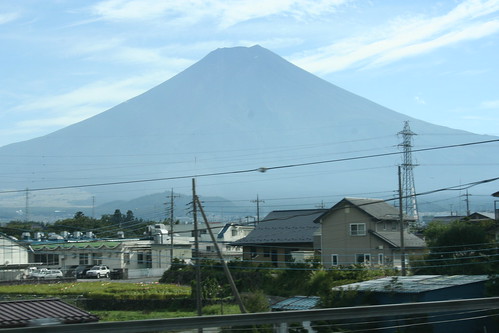
"Hmm... Shelly," I thought, "you better have a good answer to this question before you go to that mountain." When I thought about it more, I realized that most people, when talking about climbing a mountain, come from the point of view of "conquering the mountain", or "overcoming the obstacle", or other testosterone driven points of view. I certainly don't think of climbing a mountain in that way. It is much more like a dance or training, I get to go to the summit if the mountain lets me, if the mountain thinks that my heart and intention is true, it will permit me to reach its summit. And if I am lucky, it may give me teachings, the lessons I need to learn, along the way. One thing I know for certain is that I am absolutely nothing when related to the power of a mountain. Especially one as powerful as Fuji-san. It is like training with Yoshi sensei, he may permit me to throw or pin him, to teach me the lesson. Yet we both know that I am only a novice, and nothing compared to him. Before climbing any peak, I bow to the mountain, introducing myself, that I am coming in true humility, that I am asking the mountain for teachings, and thanking the mountain for the opportunity to practice with it. If I come with humble intention, I can only put my feet on Fuji-san if it permits me to do so. And if it does, I am thankful for the teaching.
We arrived in Tokyo after a 20 hour layover in Bangkok. We got ourselves organized, and went to the bus station the next day to get tickets to Fuji Go-ko, on the north side of Mt Fuji. At the station, they informed us that the bus was canceled due to an incoming Typhoon. Stuck in a Tokyo Typhoon! 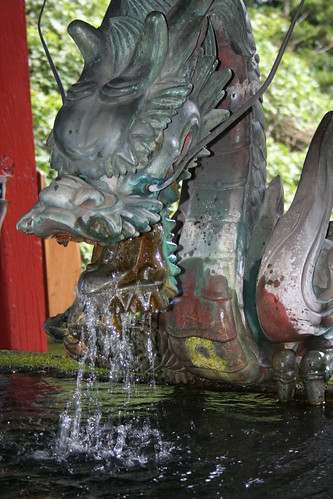 We treated ourselves to a night in the Hyatt hotel and watched the trees blow and tear, the water gust in sheets across the streets below, from a room in the 27th floor. It was very cool!
We treated ourselves to a night in the Hyatt hotel and watched the trees blow and tear, the water gust in sheets across the streets below, from a room in the 27th floor. It was very cool!
The next day we were able to get the bus, and spent the night in Kawaguchi-ko. We headed to the town of Fuji-Yoshida in the morning and began our traditional assent of the mountain by first walking under the Torii (gate arch) in the middle of town that designates the entrance to the spiritual world from the physical world. Then we walked through another Torii and along the towering cryptomeria trees, peppered with old stone lanterns,  to the Sengen-jinja shrine. It is traditional to climb Fuji-san from the bottom, at the Sengen-jinja shrine, and up the Yoshidaguchi trail.
to the Sengen-jinja shrine. It is traditional to climb Fuji-san from the bottom, at the Sengen-jinja shrine, and up the Yoshidaguchi trail. 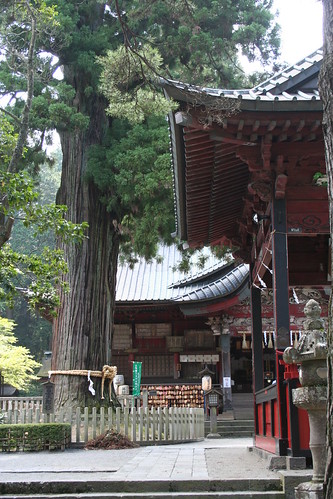 We paid homage to the gods at the shrine, then began the 19 km assent.
We paid homage to the gods at the shrine, then began the 19 km assent. 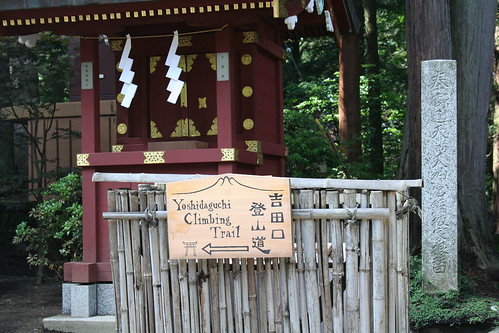 Yoshidaguchi trail is the oldest path up the mountain. We passed through lush forests that we had almost entirely to ourselves (most people take the bus to the Kawaguchi-ko 5th station, and start there) . We passed Nakanochaya, an ancient site marked by carved stones left by previous climbers/pilgrims.
Yoshidaguchi trail is the oldest path up the mountain. We passed through lush forests that we had almost entirely to ourselves (most people take the bus to the Kawaguchi-ko 5th station, and start there) . We passed Nakanochaya, an ancient site marked by carved stones left by previous climbers/pilgrims. 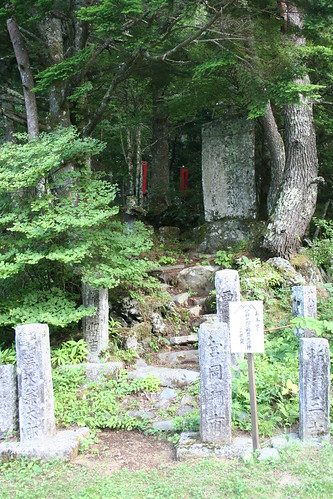 We walked through the Torii, with monkeys on either side, that marks the formal entrance to the sacred area of the mountain.
We walked through the Torii, with monkeys on either side, that marks the formal entrance to the sacred area of the mountain.  Then past the 1st, 2nd, and 3rd stations to the Nyonin Tenjo (women's holy ground) which until 1832 was as far up as women were allowed to go. On we went until we arrived at the 5th station hut on the Yoshidaguchi trail (2305 m). We had reserved space in the hut, so when we arrived, we were warmly greeted, shown our bed space, then washed up before being served dinner.
Then past the 1st, 2nd, and 3rd stations to the Nyonin Tenjo (women's holy ground) which until 1832 was as far up as women were allowed to go. On we went until we arrived at the 5th station hut on the Yoshidaguchi trail (2305 m). We had reserved space in the hut, so when we arrived, we were warmly greeted, shown our bed space, then washed up before being served dinner. 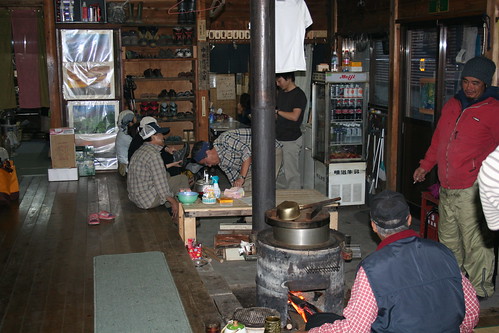
Before bed we admired some cool photos on the walls of Japanese mountaineers climbing Fuji-san in the winter. The mountain's 35-40 degree constant angle would make a fine 5000 vertical foot ski decent from the summit. One day we should come back with skis!
The next morning, at 3:30 am, we scarfed down some rice balls they had left us for breakfast (one with salmon inside!), drank a cup of green tea, and started up the mountain trail. The trail was very quiet until we reached the intersection with the trail coming from the Kawaguchi-ko 5th station. And it was still relatively uncrowded as we passed the 6th, and maybe 7th, stations.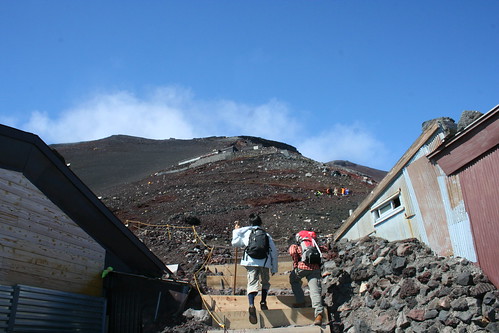 We got a bit confused as to which of the seemingly continuous string of buildings, cafes, and hotels, was officially which station.
We got a bit confused as to which of the seemingly continuous string of buildings, cafes, and hotels, was officially which station.
We paused to watch a golden sunrise over the low clouds, hills, and lakes East Fuji-san. 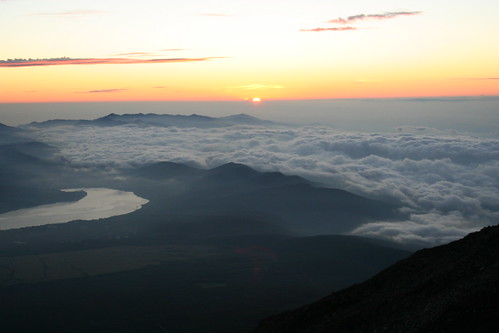 Later, as our trail started to fill with other climbers, we noticed the decent trail absolutely crowed with climbers who were at the summit for sunrise.
Later, as our trail started to fill with other climbers, we noticed the decent trail absolutely crowed with climbers who were at the summit for sunrise. 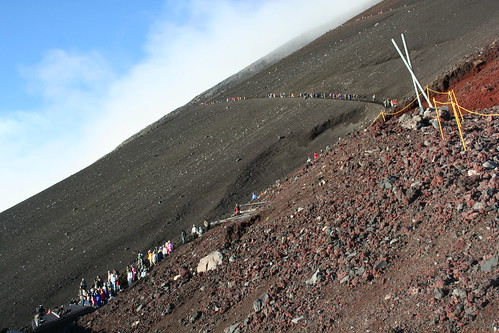 Around the same time, a thick fog began to accumulate around the summit. When we walked under a small Torii,
Around the same time, a thick fog began to accumulate around the summit. When we walked under a small Torii,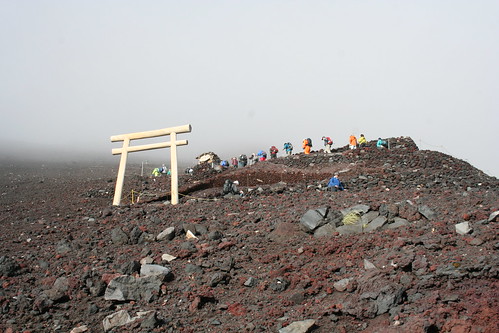 and up to a plateau with cafes selling hot tea, we thought we were at station 8. We took a rest, put on our cold weather gear (we were inside a cold blowing cloud by this time), and asked a group of climbers where the trail continuing to the summit was. They said "this IS the summit!" (oops- we didn't even know that we made it to the top :}) . It took 3.5 hours to climb the 1500 m from 5th station.
and up to a plateau with cafes selling hot tea, we thought we were at station 8. We took a rest, put on our cold weather gear (we were inside a cold blowing cloud by this time), and asked a group of climbers where the trail continuing to the summit was. They said "this IS the summit!" (oops- we didn't even know that we made it to the top :}) . It took 3.5 hours to climb the 1500 m from 5th station.
We walked over to the Torii at the 9th station (that is the summit station), and took the obligatory summit photos. 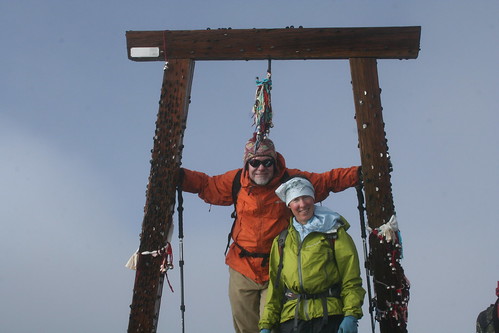 We then continued on, to circumnavigate the summit cone ridge clockwise. We stopped at the weather station, which is the true highest point (3776m/12,388ft), and continued to a nice rounded open area were we paused to rest and reflect.
We then continued on, to circumnavigate the summit cone ridge clockwise. We stopped at the weather station, which is the true highest point (3776m/12,388ft), and continued to a nice rounded open area were we paused to rest and reflect.
This summit has seen many wise and clear people. According to early Shugendo myths, the mountain was first climbed by the wizard/sage En No Gyoja around 700 AD. And from the 15th century onward it became a popular pilgrimage destination. They say that this crater is the home of the fire goddess, the dwelling of the Shinto goddess of flowing trees, and the abode of Dainichi Nyorai (the Buddha of all-illuminating wisdom).
As we sat there, magically, the clouds suddenly opened up. We basked thankfully in some warm rays before completing the circumnavigation and heading down. The decent route was hellish; just a long set of steep gravel switchback, switchback, switchback, switchbacks. Our knees were aching by the time we made it back to the 5th station hut where we had left our sleeping bags and toothbrushes. We had a snack there, and asked the hut owner, "how far is the bus down to Fuji-Yoshida?". And he said, "20 meters". Since our bus, the last one, left at 3:30, we thought we would leave the hut around 3:15, with plenty of time to spare. We settled down on the grass mat floor to watch a marathon race on TV. The owner kept reminding us what time the bus left, getting more nervous each time. We kept looking at each other thinking, "what's the big deal? We have plenty of time." When finally at 3:15, he grabs our bags and motions us to follow him to his jeep. We get in, not quite sure why we have to drive the 20 meters to the bus pick up, but we kept driving and driving. Soon, we arrived at the bus with only a couple minutes to spare. It turns out that he was telling us 20 minutes, not 20 meters! Ooops.
That night we went to a small local Izakaya (the Japanese equivalent of a Pub) for dinner. The couple who owned and ran it were so excited to have some foreigners there, and we were so incapable of telling them in Japaneese what we wanted to eat, that they called their daughter and her husband (who speaks English) to come and join us for dinner. We ate the specialties of the house and drank plenty of sake to the great Fuji-san.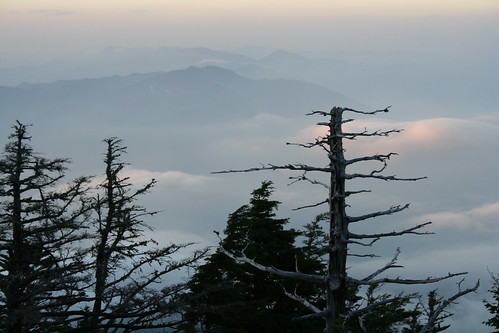
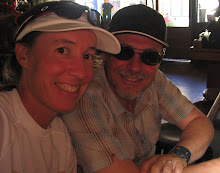
No comments:
Post a Comment